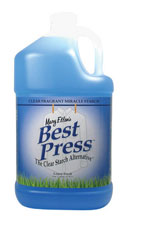This post contains affiliate links for which I receive compensation
How to make a pressing board

I want to cover plywood with cotton batting and muslin to make a large pressing board that I can use a very hot iron on.
What type of cotton batting should I use - with or without scrim and what other factors should I be aware of?
How many layers of batting should I use and should I wash the batting and put it in the dryer first since I will sometimes use steam on my pressing board?
Can you recommend a brand of batting?
Thanks for your help.
MJ
Reply
The video instructions that I used to make my own pressing boards -- TOTALLY LOVE! a hard pressing surface--are shown further down on this page.To address your specific questions...
I strongly suggest that you use a 100% cotton duck (you can find it at a store like Joann's). I like how it grips the patches so much better than muslin. The surface of the duck is more 'grippy' due to the larger size of the threads that make it. I did pre-wash mine to shrink it first, particularly because I use a lot of steam in my pressing and I didn't know how much it might shrink. Do pull it out of the dryer BEFORE it's bone dry...it's a pain in the rear to iron when it gets wrinkled (ask me how I know!)
As for batting, I used the 100% cotton Warm and Natural, one layer. Remember, though, that this is YOUR work surface, if you find that you like one a bit softer...then add another layer of batting.
Yes, it does have a poly scrim but I haven't found that to be a problem.
The packaging suggests a 3% shrinkage rate when washed after the quilt is quilted. (In fact, The Warm Company discourages prewashing their Warm & Natural batting before it is put into a quilt.) I haven't noticed any problems. In the method shown in the video below, notice how the batting isn't stapled...the duck holds everything in place.
As for the spray adhesive...didn't use it...don't keep it on hand and don't particularly care for the product. I found that the wood and the duck helped control the batting while I stapled.
And now here's the video to show you how it's made:
For a more portable (read 'lighter weight') pressing board, one of my girlfriend's used a piece of the foil covered insulation...cut to about 4 foot by 18-20". She takes this to all of our bee treats. It is set on the counter and makes a nice surface to work on. Again...foil covered.
The really nice thing about making your own pressing boards is that you can make them sized to fit what you need...particularly one wide enough to press full width's of fabric.
I use a lot of starch in my piecing...in my opinion the end result is more accurate with less effort. But starch really yucks up that top layer of cotton fabric. When it gets too gross, I have stapled one additional layer of new cotton duck over the first one if I don't want to take the time to remove it. I usually (if it's handy) put an extra layer of muslin over the top when I'm starching, too.
Thank you for your question.
More 'pressing matters'...
These articles may also be of interest to you.- Starching Quilt Fabric and How to Make Liquid Starch
- Pressing Quilt Blocks: Tips for Flatter Blocks
- Perfect Points for Impeccable Patchwork
Readers, how and what do you use if you make your own pressing boards? Just the 'comments' link below to share your ideas! Thank you!
Piecefully,
Julie Baird
Editor
Comments for How to make a pressing board
|
||
|
||
|
||
|
||
|
||















